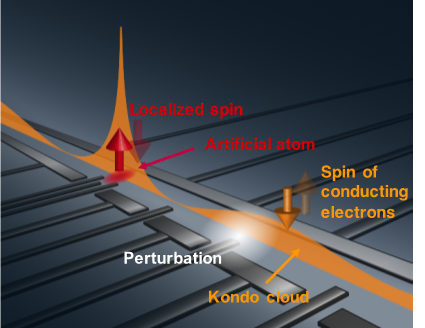Mar. 12, 2020 Press Release Physics / Astronomy
For the first time, scientists observe the elusive Kondo screening cloud
In research published in Nature, an international research group have ended a fifty-year quest by directly observing a quantum phenomenon known as a Kondo screening cloud. This phenomenon, which is important for many physical phenomena such as high-temperature superconductivity, is essentially a cloud that masks magnetic impurities in a material. It was known to exist but its spatial extension had never been observed, creating controversy over whether such an extension actually existed.
Magnetism arises from a property of electrons known as spin, meaning that they have angular momentum aligned in one of either two directions, conventionally known as up and down. However, due to a phenomenon known as the Kondo effect, the spins of conduction electrons—the electrons that flow freely in a material—become entangled with a localized magnetic impurity, and effectively screen it. The strength of this spin coupling, calibrated as a temperature, is known as the Kondo temperature. The size of the cloud is another important parameter for a material containing multiple magnetic impurities because the spins in the cloud couple with one another and mediate the coupling between magnetic impurities when the clouds overlap. This happens in various materials such as Kondo lattices, spin glasses, and high temperature superconductors.
Although the Kondo effect for a single magnetic impurity is now a text-book subject in many-body physics, detection of its key object, the Kondo cloud and its length, has remained elusive despite many attempts during the past five decades. Experiments using nuclear magnetic resonance or scanning tunneling microscopy, two common methods for understanding the structure of matter, have either shown no signature of the cloud, or demonstrated a signature only at a very short distance, less than 1 nanometer, so much shorter than the predicted cloud size, which was in the micron range.
In the present study, the authors observed a Kondo screening cloud formed by an impurity defined as a localized electron spin in a quantum dot—a type of “artificial atom”—coupled to quasi-one-dimensional conduction electrons, and then used an interferometer to measure changes in the Kondo temperature, allowing them to investigate the presence of a cloud at the interferometer end. Essentially, they slightly perturbed the conduction electrons at a location away from the quantum dot using an electrostatic gate. The wave of conducting electrons scattered by this perturbation returned back to the quantum dot and interfered with itself. This is similar to how a wave on a water surface being scattered by a wall forms a stripe pattern. The Kondo cloud is a quantum mechanical object which acts to preserve the wave nature of electrons inside the cloud. Even though there is no direct electrostatic influence of the perturbation on the quantum dot, this interference modifies the Kondo signature measured by electron conductance through the quantum dot if the perturbation is present inside the cloud. In the study, the researchers found that the length as well as the shape of the cloud is universally scaled by the inverse of the Kondo temperature, and that the cloud’s size and shape were in good agreement with theoretical calculations. “Thus, we were able experimentally to confirm the original theoretical prediction of the Kondo cloud length which is on the order of micrometers,” said Ivan Borzenets of the City University of Hong Kong, who performed the experimental measurements.
According to Michihisa Yamamoto of the RIKEN Center for Emergent Matter Science (CEMS), who led the international collaboration, “It is very satisfying to have been able to obtain real space image of the Kondo cloud, as it is a real breakthrough for understanding various systems containing multiple magnetic impurities. This achievement was only made possible by close collaboration with theorists. The size of the Kondo cloud in semiconductors was found to be much larger than the typical size of semiconductor devices. This means that the cloud can mediate interactions between distant spins confined in quantum dots, which is a necessary protocol for semiconductor spin-based quantum information processing. This spin-spin interaction mediated by the Kondo cloud is unique since both its strength and sign (two spins favor either parallel or anti-parallel configuration) are electrically tunable, while conventional schemes cannot reverse the sign. This opens up a novel way to engineer spin screening and entanglement.” Heung-Sun Sim of KAIST, the theorist who proposed the method for detecting the Kondo cloud, also said, “The observed spin cloud is a micrometer-size object that has quantum mechanical wave nature and entanglement. This is why the spin cloud has not been observed despite a long search. It is remarkable in a fundamental and technical point of view that such a large quantum object can now be created, controlled, and detected.”
The work was done by researchers from RIKEN CEMS, the City University of Hong Kong, Korea Advanced Institute of Science and Technology (KAIST), University of Tokyo, and Ruhr-University Bochum.
Reference
- Borzenets et al., Observation of the Kondo screening cloud (2020). Nature. Doi: 10.1038/s41586-020-2058-6.
Contact
Unit Leader
Michihisa Yamamoto
Quantum Electron Device Research Unit
Center for Emergent Matter Science
Group Director
Seigo Tarucha
Quantum Functional System Research Group
Center for Emergent Matter Science
Jens Wilkinson
RIKEN International Affairs Division
E-mail: gro-pr[at]riken.jp

Outline of the experiment
